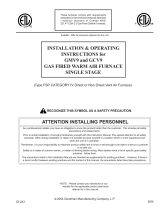
6
P
RODUCT
D
ESCRIPTION
& A
PPLICATION
SHIPPING INSPECTION
All units are securely packed in shipping containers tested ac-
cording to International Safe Transit Association specifications.
The carton must be checked upon arrival for external damage. If
damage is found, a request for inspection by carrier’s agent
must be made in writing immediately.
The furnace must be carefully inspected on arrival for damage
and bolts or screws which may have come loose in transit. In
the event of damage the consignee should:
1. Make a notation on delivery receipt of any visible damage
to shipment or container.
2. Notify carrier promptly and request an inspection.
3. With concealed damage, carrier must be notified as soon
as possible - preferably within five days.
4. File the claim with the following support documents within
a nine month statute of limitations.
• Original or certified copy of the Bill of Lading, or
indemnity bond.
• Original paid freight bill or indemnity in lieu thereof.
• Original or certified copy of the invoice, showing trade
and other discounts or reductions.
• Copy of the inspection report issued by carrier’s
representative at the time damage is reported to carrier.
The carrier is responsible for making prompt inspection of dam-
age and for a thorough investigation of each claim. The distribu-
tor or manufacturer will not accept claims from dealers for trans-
portation damage.
ELECTROSTATIC DISCHARGE (ESD) PRECAUTIONS
NOTE: Discharge body’s static electricity before touching unit.
An electrostatic discharge can adversely affect electrical com-
ponents.
Use the following precautions during furnace installation and
servicing to protect the integrated control module from damage.
By putting the furnace, the control, and the person at the same
electrostatic potential, these steps will help avoid exposing the
integrated control module to electrostatic discharge. This pro-
cedure is applicable to both installed and non-installed (un-
grounded) furnaces.
1. Disconnect all power to the furnace. Do not touch the
integrated control module or any wire connected to the
control prior to discharging your body’s electrostatic
charge to ground.
2. Firmly touch a clean, unpainted, metal surface of the
furnaces near the control. Any tools held in a person’s
hand during grounding will be discharged.
3. Service integrated control module or connecting wiring
following the discharge process in step 2. Use caution
not to recharge your body with static electricity; (i.e., do
not move or shuffle your feet, do not touch ungrounded
objects, etc.). If you come in contact with an ungrounded
object, repeat step 2 before touching control or wires.
4. Discharge your body to ground before removing a new
control from its container. Follow steps 1 through 3 if
installing the control on a furnace. Return any old or new
controls to their containers before touching any ungrounded
object.
TO THE INSTALLER
Before installing this unit, please read this manual thoroughly to
familiarize yourself with specific items which must be adhered to,
including but not limited to: unit maximum external static pres-
sure, gas pressures, BTU input rating, proper electrical connec-
tions, circulating air temperature rise, minimum or maximum CFM,
and motor speed connections.
IMPORTANT N OTE TO THE OWNER REGARDING PRODUCT WAR-
RANTY
Your warranty certificate is supplied as a separate document with
the unit installed by your contractor. Read the limited warranty
certificate carefully to determine what is and is not covered and
keep the warranty certificate in a safe place. If you are unable to
locate the warranty certificate please contact your installing con-
tractor or contact customer service (877-254-4729) to obtain a
copy.
To receive the Lifetime Heat Exchanger Limited Warranty, good for
as long as you own your home, and the 10-year Parts Limited
Warranty, online registration must be completed within 60 days of
installation. Online registration is not required in California or Que-
bec.
To register your Goodman brand unit, go to www.goodmanmfg.com.
Click on the word “Warranty” located on the left side of the home
page. Next, click on the word “Product Registration” located on
the left side of the Warranty page and complete the forms in the
manner indicated on the Product Registration page.
To register your Amana brand unit, go to www.amana-hac.com.
Click on the word “Warranty” located on the top right of the home
page. Next, click on the word “Product Registration” located on
the left side of the Warranty page and complete the forms in the
manner indicated on the Product Registration page.
Product limited warranty certificates for models currently in pro-
duction can be viewed at www.goodmanmfg or www.amana-
hac.com. If your model is not currently in production or does not
appear on the website, please contact your installing contractor or
contact customer service at (877-254-4729) to obtain a copy of
your warranty certificate.
Each product overview page contains a Product Warranty link; by
clicking on it you will be able to view the limited warranty coverage
for that specific product. To view warranty registration information,
click on the Product Warranty text on the left navigation panel on
the home page of each website. The Online Product Registration
pages are located in this same section.























